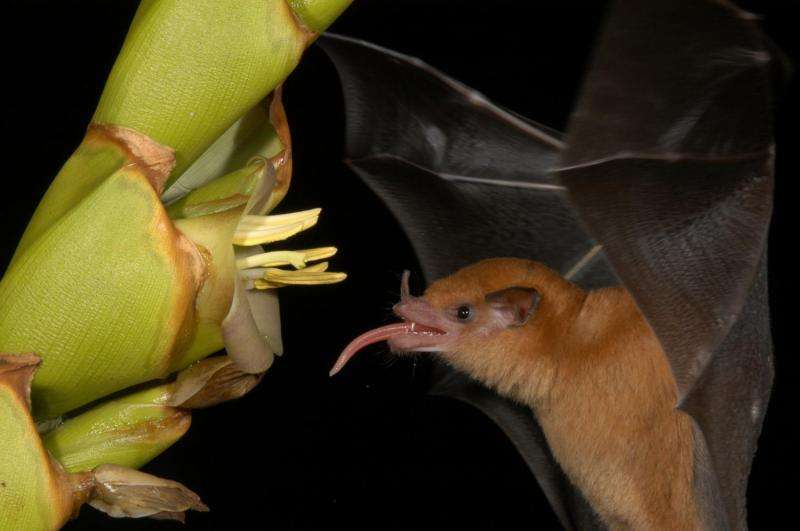September 28, 2015 report
Bat species found to have tongue pump to pull in nectar

(Phys.org)—A trio of researchers affiliated with the University of Ulm in Germany and the Smithsonian Tropical Research Institute in Panama has found that one species of bat has a method of collecting nectar that has never been seen before in any other animal. In their paper published in the journal Science Advances, the team describes how they discovered the unique eating method using high speed cameras, and their theories on how it works.
Scientists have seen many examples of animals that lap up liquid in many different ways, they have also seen examples of animals that are able to suck water right out of a river, but until now, there has never been a documented sighting of a an animal that is able to pull a liquid against gravity, using a pumping-mechanism.
Intrigued as to how Costa Rican Orange Nectar Bats pull nectar from plants, the team set up a high-speed video camera next to a test tube with a clear liquid meant to serve as nectar and recorded several of them in action. In studying the video, the researchers discovered that the bat lowered its tongue into the liquid and then simply held it there while the liquid miraculously made its way up the tongue and into the mouth. Closer examination showed that the tongue had two grooves (which were open to the air) along its length and that tiny muscles appeared to be undulating along the sides of the groves as the liquid was pulled up—serving as a pumping mechanism of some sort.
The researchers cannot say for sure what is going on, but suspect two forces are at work: capillary action and muscle force. They believe it is likely the liquid is held in the grooves by capillary action, and that the tiny muscles somehow force the liquid to move upwards, against gravity—sort of like allowing one end of a sponge to rest in water while continuously wringing out the water that is pulled into other parts. The result is an odd, unique and efficient means for drawing nectar from a flower. They note that the unique physiology of the mouth suggests that the bats evolved their way of eating independently of other species.
More information: Nectar uptake in bats using a pumping-tongue mechanism, Science Advances 25 Sep 2015: Vol. 1, no. 8, e1500525, DOI: 10.1126/sciadv.1500525
Abstract
Many insects use nectar as their principal diet and have mouthparts specialized in nectarivory, whereas most nectar-feeding vertebrates are opportunistic users of floral resources and only a few species show distinct morphological specializations. Specialized nectar-feeding bats extract nectar from flowers using elongated tongues that correspond to two vastly different morphologies: Most species have tongues with hair-like papillae, whereas one group has almost hairless tongues that show distinct lateral grooves. Recent molecular data indicate a convergent evolution of groove- and hair-tongued bat clades into the nectar-feeding niche. Using high-speed video recordings on experimental feeders, we show distinctly divergent nectar-feeding behavior in clades. Grooved tongues are held in contact with nectar for the entire duration of visit as nectar is pumped into the mouths of hovering bats, whereas hairy tongues are used in conventional sinusoidal lapping movements. Bats with grooved tongues use a specific fluid uptake mechanism not known from any other mammal. Nectar rises in semiopen lateral grooves, probably driven by a combination of tongue deformation and capillary action. Extraction efficiency declined for both tongue types with a similar slope toward deeper nectar levels. Our results highlight a novel drinking mechanism in mammals and raise further questions on fluid mechanics and ecological niche partitioning.
Journal information: Science Advances
© 2015 Phys.org




















